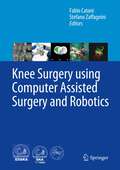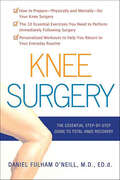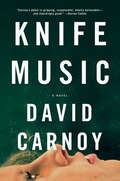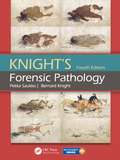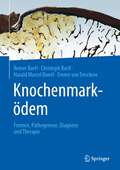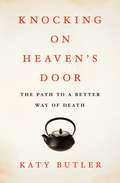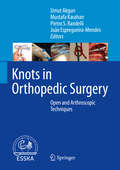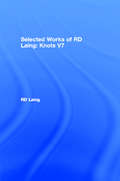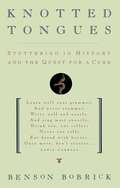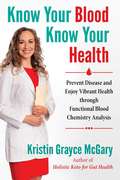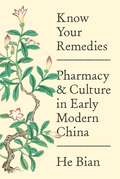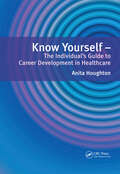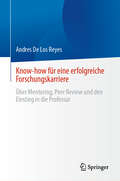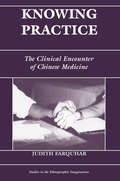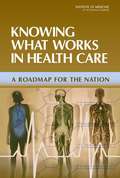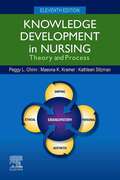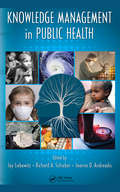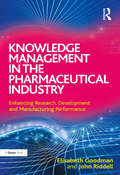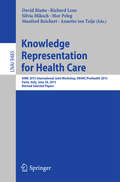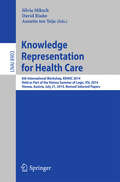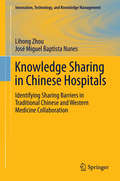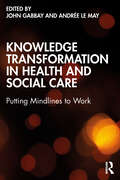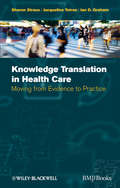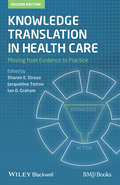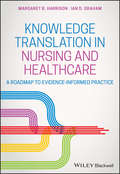- Table View
- List View
Knee Surgery using Computer Assisted Surgery and Robotics
by Stefano Zaffagnini Fabio CataniThis book discusses the full range of current applications of computer-assisted surgery and robotics in the field of knee surgery, and also considers potential future applications. The impact of computer-assisted surgery on a wide range of surgical procedures is clearly explained. Procedures considered include total knee arthroplasty, unicompartmental knee arthroplasty, cruciate ligament reconstruction, patellofemoral arthroplasty, and revision surgery. In each case, technical aspects are thoroughly addressed in a readily understandable manner. Knee Surgery Using Computer-Assisted Surgery and Robotics will be an ideal guide to this exciting field for both novice and more experienced surgeons who treat knee injuries and disorders.
Knee Surgery: The Essential Step-by-Step Guide to Total Knee Recovery
by Daniel Fulham O'NeillIn this age of same-day surgery and do-it-yourself health, Knee Surgery presents an easy-to-do, well-illustrated program of movement for knee rehabilitation - with a special focus on the mind/body connection - and describes the physical and mental rehabilitation process in complete detail, providing all the guidance you need to decrease pain and increase fitness after knee surgery. Millions of people have knee surgery each year, and in the years to come millions more will head to the O.R. Chances are, you or someone you know has had or will undergo knee surgery. Busy doctors, therapists, and athletic trainers have limited time to spend on quality physical and mental rehabilitation education, yet this is the key to full recovery.Written by renowned knee surgeon and Sport Psychologist Daniel F. O'Neill, M.D., Ed.D., this comprehensive and accessible guide presents what you'll want and need the most after knee surgery: a scientifically-based recovery program you can understand that will get you back to work and sports as quickly as possible.
Knife Music: A Novel
by David CarnoyAn emergency room surgeon must defend himself against a teenage girl’s shocking allegation “in this scalpel-sharp medical thriller” (Kirkus).Dr. Ted Cogan had saved her life when he treated her in the ER six months ago. But now police detectives are questioning him about her, in intimate detail. It seems the seventeen-year-old girl he’d saved is now dead. It looks like a suicide. And Cogan is in a heap of trouble. Accused of raping the young woman, the case against Cogan appears to be airtight. Detective Hank Madden, a disabled veteran of the Menlo Park police force, has little patience or pity for men like Cogan. Now the rich, arrogant, self-described womanizer must do whatever it takes to prove that this terrible crime is not among his many sins.
Knight's Forensic Pathology
by Bernard Knight Pekka SaukkoThe fourth edition of Knight's Forensic Pathology continues to be the definitive international resource for those in training and in practice, covering all aspects of the medico-legal autopsy, including the cause and time of death, interpretation of wounds and every other facet of the investigation of a fatality.The contents are intended to lead th
Knochenmarködem: Formen, Pathogenese, Diagnose und Therapie
by Reiner Bartl Christoph Bartl Harald Marcel Bonél Emmo von TresckowHeute kann die Diagnose eines Knochenmarködems (KMÖ) nicht mehr als eine „gutartige, selbstlimitierende Erkrankung“ eingestuft werden. Vielmehr wird das KMÖ-Syndrom als Warnsignal für den möglichen Übergang in langwierige, schmerzhafte Erkrankungen (z.B. CRPS) oder gar in eine Osteonekrose mit der Konsequenz einer endoprothetischen Versorgung angesehen. Einer klinisch/radiologisch orientierten Klassifikation des lokalen KMÖ mittels MRT kommt daher besondere prognostische Bedeutung zu. Während früher eine Anbohrung des ödematösen Bezirkes als „Mittel der Wahl“ galt, stehen heute effektive Medikamente, biophysikalische Verfahren und Kombinationstherapien zur Verfügung, die zu einer Ausheilung des Ödems und auch der zugrundeliegenden Erkrankung führen.Die vier Autoren des Buches Knochenmarködem haben bei der Abhandlung der klinischen Fächer, die mit der Diagnose und Therapie eines KMÖs konfrontiert sind, großen Wert auf eine multidisziplinäre Betrachtung gelegt. Beteiligte Fachdisziplinen wie Innere Medizin, Hämatologie und Onkologie, Osteologie, Orthopädie, Traumatologie und Sportmedizin sowie Radiologie und Pharmakologie werden fachkundig abgedeckt.
Knocking on Heaven's Door: The Path to a Better Way of Death
by Katy ButlerAn exquisitely written, expertly reported memoir and exposé of modern medicine that leads the way to more humane, less invasive end-of-life care--based on the author's acclaimed New York Times Magazine piece. This is the story of one daughter's struggle to allow her parents the peaceful, natural deaths they wanted--and to investigate the larger forces in medicine that stood in the way. When doctors refused to disable the pacemaker that caused her eighty-four-year-old father's heart to outlive his brain, Katy Butler, an award-winning science writer, embarked on a quest to understand why modern medicine was depriving him of a humane, timely death. After his lingering death, Katy's mother, nearly broken by years of nonstop caregiving, defied her doctors, refused open-heart surgery, and insisted on facing death the old-fashioned way: bravely, lucidly, and head on. Against this backdrop of familial love, wrenching moral choices, and redemption, Knocking on Heaven's Door celebrates the inventors of the 1950s who cobbled together lifesaving machines like the pacemaker--and it exposes the tangled marriage of technology, medicine, and commerce that gave us a modern way of death: more painful, expensive, and prolonged than ever before. Caring for declining parents is a reality facing millions who may someday tell a doctor: "Let my parent go." A riveting exploration of the forgotten art of dying, Knocking on Heaven's Door empowers readers to create new rites of passage to the "Good Deaths" our ancestors so prized. Like Jessica Mitford's The American Way of Death and How We Die by Sherwin Nuland, it is sure to cause controversy and open minds.
Knots in Orthopedic Surgery: Open And Arthroscopic Techniques
by Mustafa Karahan João Espregueira-Mendes Umut Akgun Pietro S. RandelliThis well-illustrated book presents the state of the art in suture materials and provides clear, step-by-step guidance on how to tie the most frequently used knots. The opening section addresses terminological issues and describes how the biological and mechanical properties of suture materials may impact on healing potential. The basics of knot biomechanics are explained, highlighting the risk of failure of knots and sutures if their capacities are exceeded. Subsequent sections give precise instructions on the tying techniques for the various open and arthroscopic knots, including the square knot, the surgeon’s knot, half hitches, and sliding and non-sliding knots. The special instruments available to facilitate the tying of arthroscopic knots are thoroughly discussed, equipping the surgeon with the knowledge required to ensure optimal handling of the soft tissues and manipulation of sutures in arthroscopic surgery. A literature review on suture materials and arthroscopic knots completes the coverage. This book is published in cooperation with ESSKA. It will be a valuable instruction manual for surgeons in training and will supply more experienced surgeons with an excellent update that will further enhance their practice.
Knots: A Realistic Novel In Collage (Selected Works of R D Laing #Vol. 7)
by RD LaingOriginally published in 1970, Knots consists of a series of dialogue-scenarios that can be read as poems or brief plays, each complete in itself. Each chapter describes a different kind of relationship: the "knots" of the title: bonds of love, dependency, uncertainty, jealousy. The dialogues could be those between lovers, between parents and children, between analysts and patients or all of these merged together. Each brilliantly demonstrates Laing's insights into the intricacies of human relationships.
Knotted Tongues: Stuttering in History and the Quest for a Cure
by Benson BobrickTwo and a half million Americans - fifty-five million people worldwide - stutter. Though their baffling malady has been subjected to endless analysis for over 2,500 years, most endure it without hope of a cure. The very anticipation of stuttering can dominate a victim's social and emotional life. If the majority suffer in anonymity, famous figures down through the ages - Moses, Charles I, Lewis Carroll, Henry James, W. Somerset Maugham, Winston Churchill, and Marilyn Monroe among them - have also known the isolation and trauma of living with knotted tongues. Indeed, Charles Dickens once aptly described stuttering as "a barrier by which the sufferer feels that the world without is separated from the world within.". In this fascinating and original social history, which combines literary scholarship with historical research, Benson Bobrick explores one of the great conundrums of medical history, its impact on the lives of the afflicted, and the astonishing therapeutic practices it has spawned. Demosthenes was obliged to labor up steep inclines with lead plates strapped to his chest and to declaim over the roar of the ocean with pebbles in his mouth; one 16th-century Italian physician prescribed nosedrops combining beetroot and coriander to help "dehumidify" the brain; and a Native American tribe had stutterers spit through a hole in a board "to get the devil out of their throats.". At one time or another, stuttering has been popularly traced to childhood trauma; sibling rivalry; suppressed anger; infantile sexual fixations; deformations of the tongue, lips, or jaw; chemical imbalance; strict upbringing; vicious habit; guilt; approach-avoidance conflicts; and so on, and has been treated by hypnosis, drugs, conditioning, electric shock, and of course, psychoanalysis. Mounting clinical evidence today, however, indicates that stuttering is a neurological problem, possibly involving anomalies of sound transmission through the skull. Genetic research suggests a familial link. While a definitive cure remains elusive, certain therapeutic techniques are effective, as the author explains in a compelling account of his own successful quest for deliverance
Know Your Blood, Know Your Health: Prevent Disease and Enjoy Vibrant Health through Functional Blood Chemistry Analysis
by Kristin Grayce McGaryA guide to accurate, individualized blood test analysis for improving personal health and avoiding disease • Explains the differences between conventional lab reference ranges for blood tests and functional analysis and why the difference is important to your health • Reveals what healthy blood should look like and the critical markers that signal the very beginnings of a health problem, including thyroid dysfunction and inflammation • Provides recommendations for bringing blood markers back to an optimal healthy range through diet and supplementation Your blood holds the clues you need to maintain vibrant health. Yet a standard blood lab panel--the most widely used diagnostic tool in Western medicine--may not reveal subclinical imbalances or the earliest beginnings of disease. Your lab work results may come back &“normal,&” even though you have lingering symptoms of allergies, pain, headaches, fatigue, inflammation, depression, food cravings, PMS, or gas and bloating. This is because the reference ranges, to which you are being compared, are gathered from sources such as textbooks, averages based on outdated guess-work, or a small number of people who aren&’t even well. You could be a tenth of a point away from a disease pattern, but diagnostic protocol won&’t sound the alarm until you are &“lab high&” on a particular test. In Know Your Blood, Know Your Health, Kristin Grayce McGary explains the benefits of a Functional Blood Chemistry Analysis (FBCA), which looks at far more markers than standard blood tests and interprets your results against healthy ranges. Using real-life stories and examples, the author explains the basics of healthy blood and how a functional blood test provides a baseline for personal health and a powerful tool for disease prevention. You will learn what is meant by a standard Complete Blood Count (CBC), find clues to strengthen your immune system, and discover which markers indicate inflammation. McGary details what different reference ranges mean and highlights the importance of a full thyroid panel for women. She reveals how health issues such as insulin resistance, high cholesterol, and anemia have specific patterns in blood chemistry. She also provides recommendations for bringing markers back to an optimal healthy range through diet and supplementation and offers a road map to using your unique blood chemistry to design a customized healthcare plan to optimize your health.
Know Your Remedies: Pharmacy and Culture in Early Modern China
by He BianA cultural history of the concept of pharmacy, both the material nature of drugs and the trade in medicine, in early modern China Know Your Remedies presents a panoramic inquiry into China’s early modern cultural transformation through the lens of pharmacy. In the history of science and civilization in China, pharmacy—as a commercial enterprise and as a branch of classical medicine—resists easy characterization. While China’s long tradition of documenting the natural world through state-commissioned pharmacopeias, known as bencao, dwindled after the sixteenth century, the ubiquitous presence of Chinese pharmacy shops around the world today testifies to the vitality of Traditional Chinese Medicine. Rejecting narratives of intellectual stagnation or an unchanging folk culture, He Bian argues that pharmacy’s history in early modern China can best be understood as a dynamic interplay between elite and popular culture.Beginning with decentralizing trends in book culture and fiscal policy in the sixteenth century, Bian reveals pharmacy’s central role in late Ming public discourse. Fueled by factional politics in the early 1600s, amateur investigation into pharmacology reached peak popularity among the literati on the eve of the Qing conquest in the mid-seventeenth century. The eighteenth century witnessed a systematic reclassification of knowledge, as the Qing court turned away from pharmacopeia in favor of a demedicalized natural history. Throughout this time, growth in long-distance trade enabled the rise of urban pharmacy shops, generating new knowledge about the natural world.Bringing together a wealth of primary sources, Know Your Remedies makes an essential contribution to the study of Chinese history and the history of medicine.
Know Yourself: The Individual's Guide to Career Development in Healthcare
by Anita HoughtonIf you work through this book I can guarantee that by the end of it two things will have happened - you will be in a much better position to plan and execute your future career and you will feel a lot better than you do now This user-friendly guide will help health professionals take control of their careers. By involving the reader in a personal journey of positive reflection the book focuses on abilities enjoyment and personal satisfaction in the workplace then based on this new-found knowledge offers advice on practical ways forward. Know Yourself is unique in using two types of therapeutic approaches to self-development; understanding the relationship between job satisfaction and personality type based on the Myers-Briggs Type Indicator and understanding how both external indicators and internal thought patterns contribute to career problems using the principles of Neuro-Linguistic Programming (NLP). Every healthcare professional who may be dissatisfied with some aspects of their work or work/life balance and will find this book inspirational and potentially life changing. It will also be of use to career advisors and counsellors.
Know-how für eine erfolgreiche Forschungskarriere: Über Mentoring, Peer Review und den Einstieg in die Professur
by Andres De Los ReyesDieses Buch behandelt wichtige Themen der beruflichen Entwicklung für junge Nachwuchs-ForscherInnen und beginnt mit Ratschlägen zur Auswahl von MentorInnen und zur Optimierung von Mentoring-Beziehungen. Auf dieser Grundlage beschreibt das Buch, wie man durch den Peer-Review-Prozess navigiert, insbesondere beim Veröffentlichen in akademischen Zeitschriften, und wie man Verbindungen zwischen den verschiedenen akademischen Arbeiten herstellt, die in den frühen Karrierejahren veröffentlicht werden. Es enthält Strategien zur Nutzung von Erzähltechniken, um ein Forschungsprogramm aufzubauen, sowie konkrete Anleitungen für akademische Vorstellungsgespräche. Darüber hinaus bietet das Buch einen Abschnitt namens „Anonyme Berichte“, der reale Beispiele dafür liefert, wie junge ForscherInnen viele Aspekte ihrer Ausbildung erlebt haben, und zeigt auf, wie man Hindernisse auf dem Weg zum Erfolg auf dem akademischen Arbeitsmarkt überwindet. Wichtige Themen sind: Auswahl und Zusammenarbeit mit MentorInnen. Umgang mit dem Peer-Review-Prozess beim Publizieren in akademischen Zeitschriften. Aufbau eines Forschungsprogramms. Durchführung akademischer Vorstellungsgespräche. Dieses Buch ist eine unverzichtbare Ressource für Graduiertenstudierende, PostdoktorandInnen und angehende Studierende sowie für andere Fachleute, die eine Ressource suchen, die ihnen hilft, im akademischen Arbeitsmarkt erfolgreich zu sein.
Knowing Practice: The Clinical Encounter of Chinese Medicine (Studies in the Ethnographic Imagination)
by Judith FarquharThis book examines the theory and practice of traditional medicine in modern China. Farquhar describes the logic of diagnosis and treatment from the inside perspective of doctors and scholars. She demonstrates how theoretical and textual materials interweave with the practical requirements of the clinic. By showing how Chinese medical choices are made, she considers problems of agency in relation to different forms of knowledge. Knowing Practice will be of value not only to anthropologists interested in medical practice but also to historians and sociologists interested in the social life of technical expertise and traditional teachings.
Knowing what Works in Health Care: A Roadmap for the Nation
by Institute of Medicine of the National AcademiesThere is currently heightened interest in optimizing health care through the generation of new knowledge on the effectiveness of health care services. The United States must substantially strengthen its capacity for assessing evidence on what is known and not known about "what works" in health care. Even the most sophisticated clinicians and consumers struggle to learn which care is appropriate and under what circumstances. Knowing What Works in Health Care looks at the three fundamental health care issues in the United States--setting priorities for evidence assessment, assessing evidence (systematic review), and developing evidence-based clinical practice guidelines--and how each of these contributes to the end goal of effective, practical health care systems. This book provides an overall vision and roadmap for improving how the nation uses scientific evidence to identify the most effective clinical services. Knowing What Works in Health Care gives private and public sector firms, consumers, health care professionals, benefit administrators, and others the authoritative, independent information required for making essential informed health care decisions.
Knowledge Development in Nursing: Theory and Process
by Peggy L. Chinn Maeona K. Kramer Kathleen SitzmanKnowledge Development in Nursing: Theory and Process, 11th Edition explores nursing theory and how it is related to nursing research and quality patient care. It examines the principles of knowledge development, using the patterns of knowing to help you develop sound clinical judgment. Each chapter begins with a Basics section, which is followed by a Now That You Know the Basics section providing a deeper understanding of knowledge patterns for more advanced learners. In addition, the content in this edition aligns with the new 2021 AACN Essentials for Nursing Education. Key content in this text is also used as the basis for the creation of the first domain within the AACN Essentials, Knowledge for Nursing Practice, and in other domains within the AACN Essentials. Written by nursing educators Peggy Chinn, Maeona Kramer, and Kathleen Sitzman, this edition reflects the latest thinking in nursing knowledge development and adds emphasis to real-world application.
Knowledge Management in Public Health
by Jay Liebowitz Richard A. Schieber Joanne D. AndreadisClose collaboration across agencies and international borders is mandatory for public health officials. A powerful tool for sharing knowledge, knowledge management (KM) can help public health professionals quickly collaborate and disseminate knowledge for solving public health issues worldwide. The latest initiatives for reforming healthcare have put the spotlight on the need for maximizing resources. In addition to providing a platform for sharing knowledge, KM can help healthcare professionals do more with less. One tool, two problems solved. Yet the sharing of knowledge and KM continues to be a major challenge in the public health field. Knowledge Management in Public Health provides a general introduction to KM and social networking in the public health arena. The book begins with coverage of basic principles, components, and methodologies as well as trends and key issues in public health. It includes ten case studies illustrating applications of KM and social networking in public health. The chapters are written by leading individuals from organizations involved in applying KM in public health worldwide. The editors and chapter authors explore the many elements of KM, delineating how and why to start such an initiative. They provide specific examples of the development and value-added benefits of KM in a variety of public health environments. Tough or quick decision making has always benefitted enormously from knowledge based on the maximum amount of pertinent information available at the time—this has not changed. What is new in the present public health environment is the need to do this more often, with fewer personnel available, and increased expectations relative to the services expected by the public. Better use of information under a KM system is well suited to serve that purpose. This book explores the many ways to use KM to anticipate potential health issues and quickly resolve key incidents when they occur.
Knowledge Management in the Pharmaceutical Industry: Enhancing Research, Development and Manufacturing Performance
by Elisabeth Goodman John RiddellThe Pharmaceutical Industry has been undergoing a major transformation since the heady days of 'big pharma' in the 1970s and 80s. Patent expiry, the rise of generics, and the decline of the blockbuster drug have all changed the landscape over the last 10-15 years. It's an environment where products can take 10 years or more to come to market, billions are spent on research and development, jobs are being shed in the western pharma homelands and regulators and the public are more demanding than ever. So what part is Knowledge Management playing and going to play in this vital international industry? Knowledge Management (KM) has many facets from providing comprehensive knowledge bases for workers, through the sharing of advice and problem solving, to providing an environment for innovation and change. This book, focusing on research and development, and manufacturing-based companies, explores how a range of techniques and approaches have been applied in the unique environment of the Pharmaceutical Industry, and examine how it can help the industry in the 21st century. Whilst the book is centered on the Pharmaceutical Industry, its objective will be to discuss and demonstrate how Knowledge Management can be applied in a variety of environments, and with a range of cultural issues. KM practitioners, and potential practitioners, both within and outside the Pharmaceutical Industry, will be able to gain valuable guidance and advice from both the examples of good practice and the lessons learned by the authors and contributors.
Knowledge Representation for Health Care
by David Riaño Richard Lenz Silvia Miksch Mor Peleg Manfred Reichert Annette Ten TeijeThis book constitutes the thoroughly refereedpost-workshop proceedings of two workshops held at the International Conferenceon Artificial Intelligence in Medicine, AIME 2015, held in Pavia, Italy, inJune 2015: the 7th International Workshop on Knowledge Representation forHealth Care, KR4HC 2015, and the 8th International Workshop on Process-orientedInformation Systems in Healthcare, ProHealth 2015. The 10 revised full papers were carefullyreviewed and selected from 26 submissions. The papers are organized in topicalsections on knowledge-driven health IT and simulation, clinical guideline andclinical pathway support, mobile process and decision support, and healthinformation systems and clinical data.
Knowledge Representation for Health Care
by David Riaño Silvia Miksch Annette Ten TeijeThis book constitutes the refereed proceedings of the 6th International Workshop on Knowledge Representation for Health Care, KR4HC 2014, held as part of the Vienna Summer of Logic, VSL 2014, in Vienna, Austria, in July 2014. The workshop aimed at attracting the interest of novel research and advances contributing in the definition, representation and exploitation of health care knowledge in medical informatics. The 12 revised full research papers and 4 short papers presented in this book were carefully reviewed and selected from 26 submissions.
Knowledge Sharing in Chinese Hospitals
by Lihong Zhou José Miguel Baptista NunesThis book aims to identify, understand and qualify barriers to the patient-centred knowledge sharing (KS) in interprofessional practice of Traditional Chinese Medicine (TCM) and Western Medicine (WM) healthcare professionals in Chinese hospitals. This collaboration is particularly crucial and unique to China since, contrary to Western practice, these two types of professionals actually work together complimentary in the same hospital. This study adopted a Grounded Theory approach as the overarching methodology to guide the analysis of the data collected in a single case-study design. A public hospital in central China was selected as the case-study site, at which 49 informants were interviewed by using semi-structured and evolving interview scripts. The research findings point to five categories of KS barriers: contextual influences, hospital management, philosophical divergence, Chinese healthcare education and interprofessional training. Further conceptualising the research findings, it is identified that KS is mostly prevented by philosophical and professional tensions between the two medical communities. Therefore, to improve KS and reduce the effects of the identified barriers, efforts should be made targeted at resolving both types of tensions. The conclusion advocates the establishment of national policies and hospital management strategies aimed at maintaining equality of the two medical communities and putting in place an interprofessional common ground to encourage and facilitate communication and KS.
Knowledge Transformation in Health and Social Care: Putting Mindlines to Work
by Andrée Le May John GabbayThe term ‘mindlines’ has become common currency in the world of research implementation and evidence-based practice. This book updates, develops and applies the mindlines model more widely. It sheds light on how we can realistically mobilise and transform research-based evidence into practice in context. This illuminating book shows how the mindlines model can be put to work. It highlights how practitioners collectively share and internalise implicit, flexible ways of rapidly handling complex clinical situations. Drawing on research and reflective studies from practice, education, and guidelines-development across a wide range of international health and care settings, the authors unpack the general components of mindlines. They find practical ways to uncover, bring together and apply specific mindlines to improve practice; and to develop evidence-based healthcare policy, practice and education in ways that capitalise on the crucial role of mindlines. Closely edited by the originators of the mindlines model, this book brings together the work of a cohesive group of researchers and practitioners to showcase and develop its theory and consequences. It is an essential read for all those interested in knowledge mobilisation, evidence-based practice, and research implementation both within healthcare and beyond.
Knowledge Translation in Health Care: Moving from Evidence to Practice
by Ian D. Graham Jacqueline Tetroe Sharon E. StrausHealth care systems worldwide are faced with the challenge of improving the quality of care. Providing evidence from health research is necessary but not sufficient for the provision of optimal care and so knowledge translation (KT), the scientific study of methods for closing the knowledge-to-action gap and of the barriers and facilitators inherent in the process, is gaining significance. Knowledge Translation in Health Care explains how to use research findings to improve health care in real life, everyday situations. The authors define and describe knowledge translation, and outline strategies for successful knowledge translation in practice and policy making. The book is full of examples of how knowledge translation models work in closing the gap between evidence and action. Written by a team of authors closely involved in the development of knowledge translation this unique book aims to extend understanding and implementation worldwide. It is an introductory guide to an emerging hot topic in evidence-based care and essential for health policy makers, researchers, managers, clinicians and trainees.
Knowledge Translation in Health Care: Moving from Evidence to Practice
by Ian D. Graham Jacqueline Tetroe Sharon E. StrausKnowledge Translation in Health Care is a practical introduction to knowledge translation for everyone working and learning within health policy and funding agencies, and as researchers, clinicians and trainees. Using everyday examples, it explains how to use research findings to improve health care in real life. This new second edition defines the principles and practice of knowledge translation and outlines strategies for successful knowledge translation in practice and policy making. It includes relevant real world examples and cases of knowledge translation in action that are accessible and relevant for all stakeholders including clinicians, health policy makers, administrators, managers, researchers, clinicians and trainees. From an international expert editor and contributor team, and fully revised to reflect current practice and latest developments within the field, Knowledge Translation in Health Care is the practical guide for all health policy makers and researchers, clinicians, trainee clinicians, medical students and other healthcare professionals seeking to improve healthcare practice.
Knowledge Translation in Nursing and Healthcare: A Roadmap to Evidence-informed Practice
by Ian D. Graham Margaret B. HarrisonKnowledge Translation in Nursing and Healthcare provides authoritative guidance on the implementation of evidence-informed practice, covering issue identification and clarification, solution building and implementation, evaluation, and sustainment. Integrating theory, empirical research, and experiential knowledge, this hands-on resource assists nurses and healthcare practitioners in collecting quality evidence, transforming it into a useable, customized recommendation, and then applying best practice in various point-of-care settings. Written by highly experienced implementation researchers working with practitioners, the book demonstrates how the synthesis and translation of evidence supports improvement of existing care and service delivery models, and produces increased benefit for both patients and health services. Examples drawn from the authors' first-hand experience—such as pressure injury prevention in acute care, transition of care for people with heart failure, and community leg ulcer care—illustrate the use of best practice in addressing care and quality issues. This important reference and guide: Outlines a planning framework that activates research and evidence in practice settings, moving knowledge into action and sustaining the use of best practice Introduces the framework that enables effective evidence-informed methodology and decision-making Features numerous illustrative field examples of both successful and unsuccessful implementations in a variety of practical situations Offers perspectives on best practice implementation from experienced practitioners and researchers Knowledge Translation in Nursing and Healthcareis a must-have for those wanting to implement, evaluate, and sustain best practice in the delivery of evidence-informed healthcare to patients, families, and communities.
